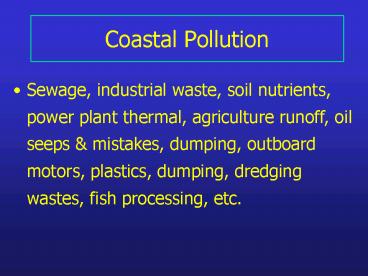Coastal Pollution PowerPoint PPT Presentation
1 / 45
Title: Coastal Pollution
1
Coastal Pollution
- Sewage, industrial waste, soil nutrients, power
plant thermal, agriculture runoff, oil seeps
mistakes, dumping, outboard motors, plastics,
dumping, dredging wastes, fish processing, etc.
2
Implications
- Biological responses (individual fitness
mortality, food web structure, etc.) - Eutrophication
- Habitat change
- Human health
- Smell
3
The cynical viewpoint
- The ultimate solution to pollution is infinite
dilution - So, dump pollutants in the infinite reservoir,
the ocean
4
The cynical viewpoint
- Makes some sense
- Economic societal costs for land-based disposal
are high - We cant see it!!
- But, what is infinite dilution
- What are safe concentrations?
5
What does the So Cal Bight Get?
6
Point Sources
- Discharge pollution from a specific location
- sewage discharge, power plant effluent, oil
produced water outlet, river, etc. - Relatively easy to identify, monitor and treat
the wastes - Need discharge permit
7
Non-Point Sources
- No specific discharge location
- Run-off from ag, urban, roads, etc.
- Ship leaks, bilges, etc.
- Rainfall sweeps the accumulated pollutants into
waterways to the ocean - Harder to identify, treat manage
8
(No Transcript)
9
(No Transcript)
10
Wastewater Discharges
- Largest source of freshwater inputs to the SoCal
Bight - Both treated sewage disposal power plant coolant
11
Waterborne Pathogens
12
Wastewater Discharges
13
Wastewater Discharges
secondary
primary
raw
14
Primary Sewage Treatment
- separates out the large solids, sand, and gravel
- then put into settling ponds where the sludge
settles out
15
Secondary Sewage Treatment
- biological degradation of organic compounds
- bacteria eats the nutrients in the waste and
decomposes them - followed by chlorine, ozone, or UV light treatment
16
Tertiary Sewage Treatment
- removes nitrates and phosphates that could cause
algal blooms - wetlands can do this naturally
17
(No Transcript)
18
Management of a Discharge
- Pollutant values need to be monitored
- Does the discharge meet is requirements?
- Need some metric of relevant pollutant
- Measure indicator organism abundance
- Hope these are related to epidemiology
19
Beach closure Performed by the local Agency
(County, or District) Intended to protect public
health Regulated through AB411 in CA
20
Whats measured Indicator bacteria
Total Coliform
Fecal Streptococcus
Fecal Coliform
Escherichia
Enterococcus
E. Coli
21
(No Transcript)
22
Confounding Issues
- Stormwater
- Leaky Septic Tanks
- Boats
- Birds, Dogs, Natural wildlife
23
(No Transcript)
24
Waterborne Pathogens
25
(No Transcript)
26
(No Transcript)
27
(No Transcript)
28
Other Materials
- Heavy metals
- mercury, lead, nickel
- highly toxic, persistent, and bio-accumulate
- result from industrial activities
- Organic Compounds
- PCB, DDT, herbicides, etc.
- DDT is most concerning
29
(No Transcript)
30
(No Transcript)
31
(No Transcript)
32
Surface sediment contamination LA County
discharge off Palos Verdes
33
Montrose Chemical Now a superfund site Dumped
TONS of DDT down sewer Ceased production in
1982 DDT has a 15 year ½ life Bioaccumulates in
some organisms
34
(No Transcript)
35
DDE is the breakdown product of DDT
36
Wastewater Discharges
- Largest source of freshwater to SoCal Bight
- Discharges include treated sewage, sludge
contaminants - Primary, secondary tertiary levels of treatment
- History of sewage technology is seen in water
quality of beaches - Montrose chemical plant created the DDT problem
37
Bioaccumulation
- Some organisms accumulate pollutants (both metals
organics) in their tissues - Biomagnification is where accumulation increases
up a trophic food chain - Well known cases are Hg, PCB, Pb (also algal
toxins) - Huge public health issue
- Some monitoring in place
38
Mussel Watch Programs
39
Regulations
- Marine Protection, Research Sanctuaries Act
(MPRSA) - Passed in 1972
- Regulates ocean dumping
- Bans radioactive, medical, sludge industrial
dumping - Regulates others
40
Point Sources
41
Regulations
- Clean Water Act
- Passed in 1972 amended in 1977 (???)
- Regulates point source discharges
- Requires a National Pollutant Discharge
Elimination System (NPDES) permit - Compliance is mandated by monitoring
42
EPAs Clean Water Act big picture
43
Present NPDES Permits from EPA
44
(No Transcript)
45
Summary
- Sources of pollutants to CA Current
- Mostly wastewater but others are important
- Bioaccumulation biomagnification
- Regulations MPRSA CWA

